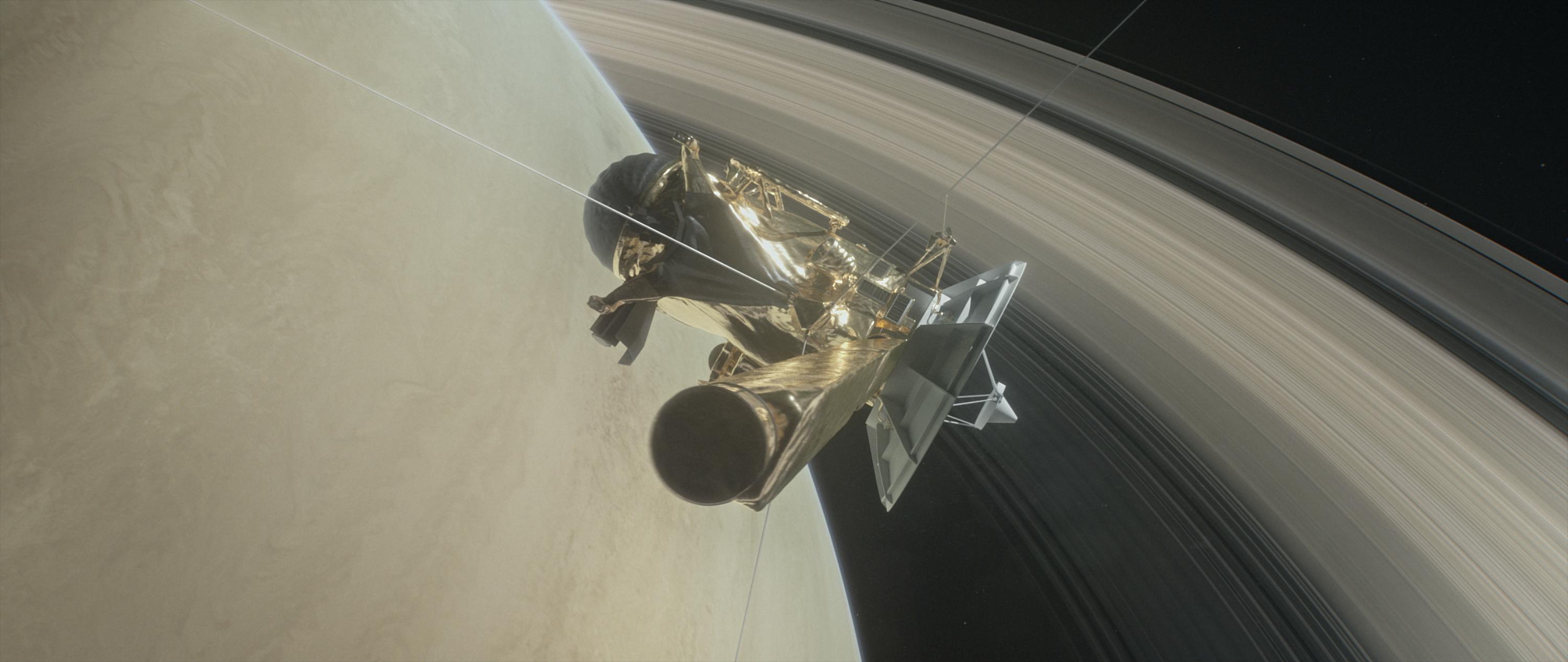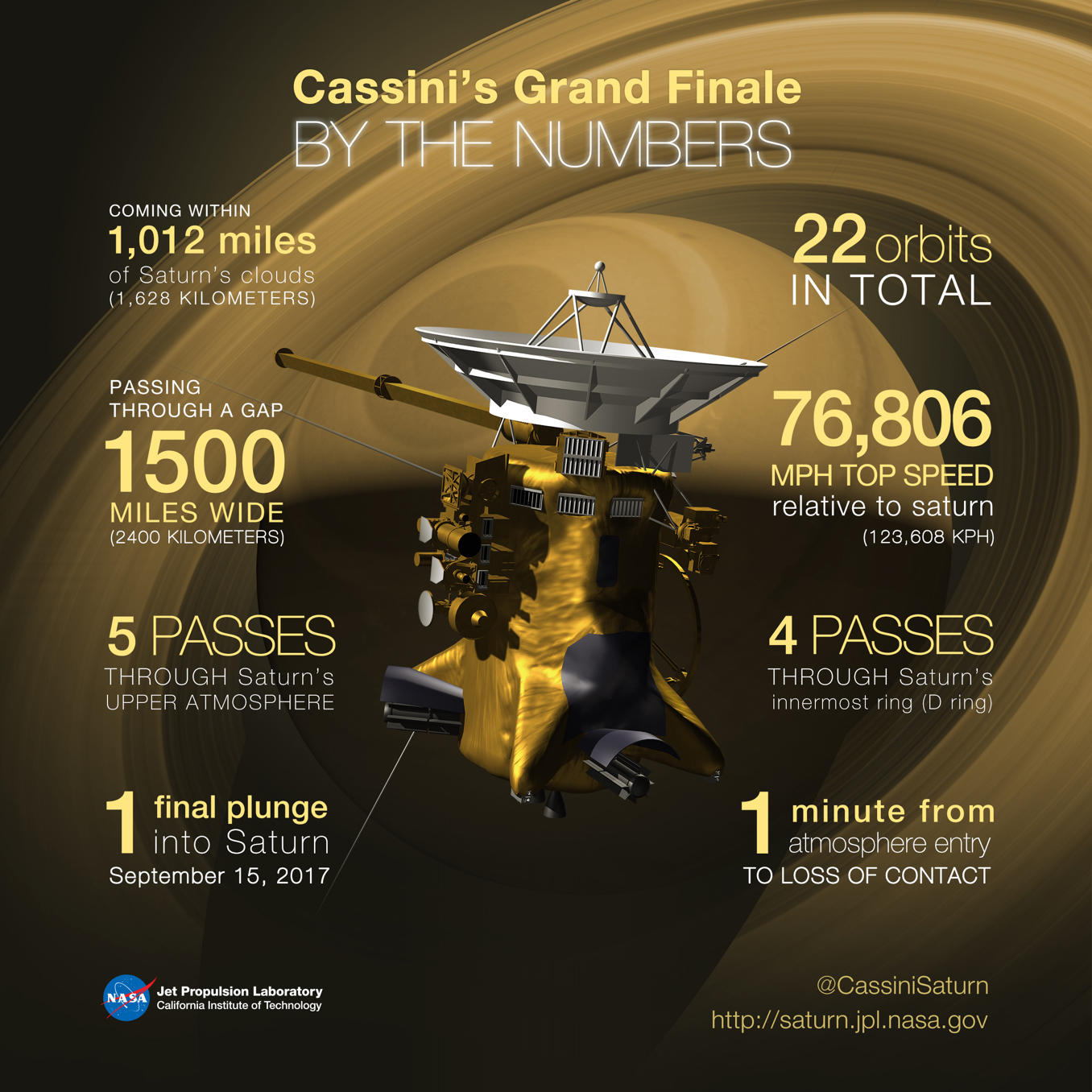As Cassini Makes 1st 'Grand Finale' Dive, More Saturn Mysteries Remain

Running low on fuel, NASA's Cassini spacecraft has begun the final — and most daring — phase of its epic mission to Saturn.
After using a final flyby of the moon Titan on Friday to boost its speed, Cassini was flung by the moon's gravity to a trajectory that sent it diving through the 1,200-mile (1,930 kilometers) gap between the planet's upper atmosphere and innermost rings, NASA officials said.
Cassini completed the first crossing of the ring plane at about 2 a.m. PDT (5 a.m. EDT, or 0900 GMT) Wednesday, the space agency said in a statement. [Cassini's "Grand Finale" at Saturn in Pictures]
This final journey will end Sept. 15 when the spacecraft burns up in Saturn's crushing atmosphere. There is no turning back now; Cassini is on a "ballistic trajectory," and its fate is sealed, NASA scientists have said. The Grand Finale has been designed to prevent the spacecraft from contaminating the potentially habitable Saturnian moons.
"We're guaranteed to end up in Saturn's atmosphere in September," said Scott Edgington, Cassini deputy project scientist at NASA's Jet Propulsion Laboratory (JPL) in Pasadena, California. "If we get hit by a particle [during the first dive] that disables the spacecraft, we are still guaranteed to end up in Saturn," he told Space.com.
Cassini is expected to be out of contact for about a day after this first dive while it takes detailed observations of Saturn and the ring gap, NASA officials said in a statement. The earliest the spacecraft is expected to check in is 12:05 a.m. PDT (3:05 a.m. EDT, or 0705 GMT) on Thursday (April 27), and it should return data and images soon after.

Saturn mysteries remain

Assuming a successful first dive, Cassini will loop around Saturn's southern hemisphere on a wide orbit, setting itself up for another 21 weekly dives that will take it to within 1,840 miles (2,960 km) of the planet's atmosphere, where it will continue its unprecedented investigations into Saturn's mysteries. NASA tracks the spacecraft's path in its Grand Finale Orbit Guide.
Get the Space.com Newsletter
Breaking space news, the latest updates on rocket launches, skywatching events and more!
Cassini launched in October 1997 through a collaboration among NASA, the European Space Agency and the Italian Space Agency, and it has been in orbit around the ringed gas giant since 2004. In that time, it has gathered numerous observations of the planet, its rings and its moons. Long-duration missions such as Cassini are essential for studying the massive planet; indeed, 13 years is a very short time to explore a world with a 29-year orbit around the sun, mission scientists said.
"We've only been at Saturn for what is, effectively, half a Saturn year," Edgington said. "But [in that time], we're seeing all these detailed changes going on within that system."
Over the course of Cassini's stay at the gas giant, ferocious storms have come and gone in Saturn's turbulent atmosphere. Planetary scientists have also been able to study the dynamics of the moon Titan's thick atmosphere, even forecasting weather systems as its seasons slowly change, Edgington noted.
But many questions remain, and hopes are high that Cassini's Grand Finale will yield some of the biggest discoveries yet to come in the 20 years since the mission's launch, Cassini researchers have said.
"The Grand Finale is a brand-new mission," Linda Spilker, Cassini project scientist at JPL, said during a news conference on April 4. "We're going to a place that we've never been before … and I think some of the biggest discoveries may come from these final orbits."
For instance, the length of a day on Saturn is still unknown, Edgington noted. The planet's axis of rotation and axis of its magnetic field are parallel, which makes it very difficult to measure how long it takes for the planet's core to complete one rotation. By making very close passes to Saturn, however, Cassini's Grand Finale will be able to measure the small-scale fluctuations in magnetism to not only pin down how long a Saturnian day is but also reveal its internal structure, he said.
"We're also going to be measuring the tiny particles that will be inside that gap [between Saturn and its rings]," Edgington said. "These are particles that come from the rings. They're charged particles; they become trapped along the magnetic-field lines that intersect the rings. And we'll be able to measure them as they travel along the magnetic field. We're talking tiny ice grains, or maybe even products of water being broken up by sunlight in that region."
These intimate studies of Saturn's rings could reveal how much material they contain and how old they are, Edgington said. Using this information, scientists could test planetary formation models that may ultimately reveal how planets evolve and how their moons accrete material, he added.
Protecting Enceladus and Titan
For Cassini's Grand Finale, scientists took significant measures to ensure Saturn's moons would not be contaminated with microbes from Earth, Edgington said.
"NASA has certain rules to follow about not contaminating any place that we think might be habitable," he said.
Although engineers put great effort into sterilizing the spacecraft before they launched, researchers have found that a few hardy bacteria can survive for long periods in extreme environments, and some of these Earth microbes may be lurking inside Cassini's components. NASA decided to incinerate Cassini at the mission's end to reduce the risk that these tough microbes would contaminate the Saturn moons Enceladus or Titan, which scientists regard as two of the best places in the solar system to search for life.
In 2005, Europe's Huygens probe landed on Titan's surface and, at the time, met all planetary protection requirements. Since Cassini has been studying Titan over the years after Huygen's landing, however, the atmospheric moon's habitable potential has become clear. The potential habitability and planetary protection standards for Enceladus are higher than for Titan, but making sure Cassini avoids both moons is a bonus, said Cassini mission scientists.
Enceladus is a small, icy moon that could easily fit inside the state of New Mexico, but its implication in the search for life elsewhere in the solar system is huge. Thanks to Cassini, we now know that Enceladus has a subsurface ocean of liquid water that erupts through the moon's ice as plumes. The spacecraft has been able to "taste" the particles being released to space, revealing that the moon contains organic molecules (carbon-containing compounds).
Most recently, the discovery of molecular hydrogen in these plumes has revealed that there are chemical interactions between the moon's rocky core and the warm water surrounding it. These interactions could mimic the conditions surrounding deep-sea hydrothermal vents on Earth, and microbes thrive around these vents and use molecular hydrogen for energy, scientists have said.
"Something's going on in there! You have geologic activity, hot water chemistry going on, which is creating an environment for the molecules that life-forms might need," Edgington said. "So yes, we want to protect Enceladus.
"But we also want to protect Titan," he added. "Titan has been a keystone for the majority of our mission."
Titan is the largest of Saturn's 62 known moons. It sports a thick, nitrogen-rich atmosphere with a surface covered in hydrocarbon chemicals. Although it is very cold, with seas and lakes of liquid methane and ethane, scientists believe it has a lot in common with the early Earth, before life took hold on our planet.
"Cassini's up-close exploration of Titan is now behind us," Spilker said in a statement, "but the rich volume of data the spacecraft has collected will fuel scientific study for decades to come."
Follow Ian O'Neill @astroengine. Follow us @Spacedotcom, Facebook and Google+. Original article on Space.com.
Join our Space Forums to keep talking space on the latest missions, night sky and more! And if you have a news tip, correction or comment, let us know at: community@space.com.
Ian O'Neill is a media relations specialist at NASA's Jet Propulsion Laboratory (JPL) in Southern California. Prior to joining JPL, he served as editor for the Astronomical Society of the Pacific‘s Mercury magazine and Mercury Online and contributed articles to a number of other publications, including Space.com, Space.com, Live Science, HISTORY.com, Scientific American. Ian holds a Ph.D in solar physics and a master's degree in planetary and space physics.









